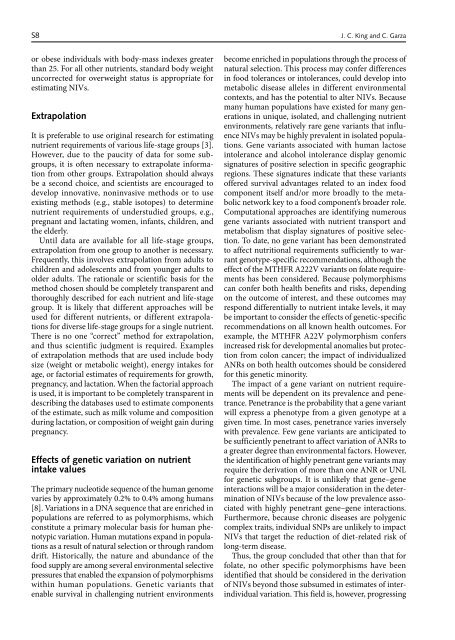Implementing food-based dietary guidelines for - United Nations ...
Implementing food-based dietary guidelines for - United Nations ...
Implementing food-based dietary guidelines for - United Nations ...
You also want an ePaper? Increase the reach of your titles
YUMPU automatically turns print PDFs into web optimized ePapers that Google loves.
S8 J. C. King and C. Garza<br />
or obese individuals with body-mass indexes greater<br />
than 25. For all other nutrients, standard body weight<br />
uncorrected <strong>for</strong> overweight status is appropriate <strong>for</strong><br />
estimating NIVs.<br />
Extrapolation<br />
It is preferable to use original research <strong>for</strong> estimating<br />
nutrient requirements of various life-stage groups [3].<br />
However, due to the paucity of data <strong>for</strong> some subgroups,<br />
it is often necessary to extrapolate in<strong>for</strong>mation<br />
from other groups. Extrapolation should always<br />
be a second choice, and scientists are encouraged to<br />
develop innovative, noninvasive methods or to use<br />
existing methods (e.g., stable isotopes) to determine<br />
nutrient requirements of understudied groups, e.g.,<br />
pregnant and lactating women, infants, children, and<br />
the elderly.<br />
Until data are available <strong>for</strong> all life-stage groups,<br />
extrapolation from one group to another is necessary.<br />
Frequently, this involves extrapolation from adults to<br />
children and adolescents and from younger adults to<br />
older adults. The rationale or scientific basis <strong>for</strong> the<br />
method chosen should be completely transparent and<br />
thoroughly described <strong>for</strong> each nutrient and life-stage<br />
group. It is likely that different approaches will be<br />
used <strong>for</strong> different nutrients, or different extrapolations<br />
<strong>for</strong> diverse life-stage groups <strong>for</strong> a single nutrient.<br />
There is no one “correct” method <strong>for</strong> extrapolation,<br />
and thus scientific judgment is required. Examples<br />
of extrapolation methods that are used include body<br />
size (weight or metabolic weight), energy intakes <strong>for</strong><br />
age, or factorial estimates of requirements <strong>for</strong> growth,<br />
pregnancy, and lactation. When the factorial approach<br />
is used, it is important to be completely transparent in<br />
describing the databases used to estimate components<br />
of the estimate, such as milk volume and composition<br />
during lactation, or composition of weight gain during<br />
pregnancy.<br />
Effects of genetic variation on nutrient<br />
intake values<br />
The primary nucleotide sequence of the human genome<br />
varies by approximately 0.2% to 0.4% among humans<br />
[8]. Variations in a DNA sequence that are enriched in<br />
populations are referred to as polymorphisms, which<br />
constitute a primary molecular basis <strong>for</strong> human phenotypic<br />
variation. Human mutations expand in populations<br />
as a result of natural selection or through random<br />
drift. Historically, the nature and abundance of the<br />
<strong>food</strong> supply are among several environmental selective<br />
pressures that enabled the expansion of polymorphisms<br />
within human populations. Genetic variants that<br />
enable survival in challenging nutrient environments<br />
become enriched in populations through the process of<br />
natural selection. This process may confer differences<br />
in <strong>food</strong> tolerances or intolerances, could develop into<br />
metabolic disease alleles in different environmental<br />
contexts, and has the potential to alter NIVs. Because<br />
many human populations have existed <strong>for</strong> many generations<br />
in unique, isolated, and challenging nutrient<br />
environments, relatively rare gene variants that influence<br />
NIVs may be highly prevalent in isolated populations.<br />
Gene variants associated with human lactose<br />
intolerance and alcohol intolerance display genomic<br />
signatures of positive selection in specific geographic<br />
regions. These signatures indicate that these variants<br />
offered survival advantages related to an index <strong>food</strong><br />
component itself and/or more broadly to the metabolic<br />
network key to a <strong>food</strong> component’s broader role.<br />
Computational approaches are identifying numerous<br />
gene variants associated with nutrient transport and<br />
metabolism that display signatures of positive selection.<br />
To date, no gene variant has been demonstrated<br />
to affect nutritional requirements sufficiently to warrant<br />
genotype-specific recommendations, although the<br />
effect of the MTHFR A222V variants on folate requirements<br />
has been considered. Because polymorphisms<br />
can confer both health benefits and risks, depending<br />
on the outcome of interest, and these outcomes may<br />
respond differentially to nutrient intake levels, it may<br />
be important to consider the effects of genetic-specific<br />
recommendations on all known health outcomes. For<br />
example, the MTHFR A22V polymorphism confers<br />
increased risk <strong>for</strong> developmental anomalies but protection<br />
from colon cancer; the impact of individualized<br />
ANRs on both health outcomes should be considered<br />
<strong>for</strong> this genetic minority.<br />
The impact of a gene variant on nutrient requirements<br />
will be dependent on its prevalence and penetrance.<br />
Penetrance is the probability that a gene variant<br />
will express a phenotype from a given genotype at a<br />
given time. In most cases, penetrance varies inversely<br />
with prevalence. Few gene variants are anticipated to<br />
be sufficiently penetrant to affect variation of ANRs to<br />
a greater degree than environmental factors. However,<br />
the identification of highly penetrant gene variants may<br />
require the derivation of more than one ANR or UNL<br />
<strong>for</strong> genetic subgroups. It is unlikely that gene–gene<br />
interactions will be a major consideration in the determination<br />
of NIVs because of the low prevalence associated<br />
with highly penetrant gene–gene interactions.<br />
Furthermore, because chronic diseases are polygenic<br />
complex traits, individual SNPs are unlikely to impact<br />
NIVs that target the reduction of diet-related risk of<br />
long-term disease.<br />
Thus, the group concluded that other than that <strong>for</strong><br />
folate, no other specific polymorphisms have been<br />
identified that should be considered in the derivation<br />
of NIVs beyond those subsumed in estimates of interindividual<br />
variation. This field is, however, progressing




